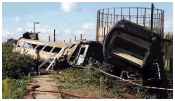|
|
|
|
|
|
|
|
|
|
|

 Yahoo UK Full Coverage  Great Western Trains  Railtrack  Health & Safety Executive  Metropolitan Police  British Transport Police 
 Second HSE Interim Report Health & Safety Executive  Green for Danger - The Phantom signal by Ray State  Beware the Paddington witch hunt This Is London - 13 Oct 99 
 Should Railtrack be nationalised? Register your view 
 Seven days . . . . . . web focus on rail safety and accidents in the last week |
|||||
Paddington Rail Tragedy: 2nd interim report says signal could be obscuredHSE : Friday, October 29, 1999The Health and Safety Executive (HSE) has today released a second interim report into
Vic Coleman, HSE's Chief Inspector of Railways, said: "The investigation is not yet complete but we have made progress in some key areas and felt it was time to publish a further report." Bob Smallwood, HSE's Deputy Chief Inspector of Railways continued, "It remains our view that the initial cause of the accident was that the Thames 165 train passed a red signal. However, it also remains our view that the reasons for this are likely to be complex. More work needs to be done on the underlying causes of the accident before we can come to any firm conclusions. "The first report said that the evidence so far suggested that the signalling was not at fault. The on-site testing of signal SN109 and related equipment has been completed and the results to date continue to support this initial assessment. However, detailed off-site testing is still going on. "There has been a lot of speculation about the ability of the driver of the Thames 165 train to see the signals clearly on 5 October. "On 13 October representatives of the Railway Inspectorate, British Transport Police, Thames Trains, Great Western Trains, ASLEF and RMT travelled in a test train and followed the route taken by the Thames 165 train out of Paddington towards SN109. Nothing was observed that provided definite evidence about what the driver would have seen on 5 October. "It was established that - depending on a driver's height and position in the cab - initial sighting of SN109 could be intermittently interrupted by the overhead electrical system; and that the green aspect of the signal would be obscured. However, we judge at present that the signalling complied with existing design standards. Mr Smallwood went on: "Preliminary analysis of the data from the rear carriage recorder of the Thames 165 train shows the following:
"As for the High Speed Train's undamaged carriages, testing of the brakes and wheel slide protection, the operation of the central door locking system, and the sliding internal carriage doors has all been completed. We conclude that there was satisfactory operation in each case. "Further tests are planned to assess the operability of the Automatic Warning System on both trains and on samples of the fuel. Initial analysis suggests there was nothing unusual about the fuel which would have led to raised fire-risks. "Work is also in hand to look at the spread of the fire, the crash-worthiness of the vehicles and human factors issues. There is still much to be done but the various strands of the investigation are coming together and we expect to be able to report more fully within a few more weeks," Mr Smallwood concluded. In an annex to the report HSE has also made public a summary of the enforcement action taken to date and of other initiatives. In addition to follow-up work arising out of the Signals Passed at Danger (SPADs) Report, which the Railway Inspectorate published in September, the Inspectorate has considered driver training and competence and has commissioned the Railway Industry Training Council to develop a training package specifically to support 'defensive driving' techniques.
Join the discussion . . . |
|
|
